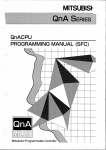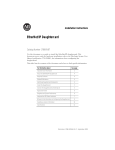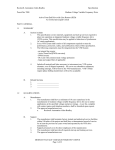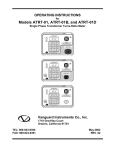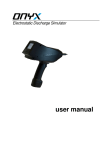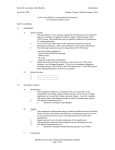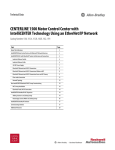Download Spec Sheet - The Reynolds Company
Transcript
User Manual Medium Voltage 400A Contactor - Series E Publication Number 1502-UM052H-EN-P Important User Information Read this document and the documents listed in the Additional Resources section about installation, configuration, and operation of this equipment before you install, configure, operate, or maintain this product. Users are required to familiarize themselves with installation and wiring instructions in addition to requirements of all applicable codes, laws, and standards. Activities including installation, adjustments, putting into service, use, assembly, disassembly, and maintenance are required to be carried out by suitably trained personnel in accordance with applicable code of practice. If this equipment is used in a manner not specified by the manufacturer, the protection provided by the equipment may be impaired. In no event will Rockwell Automation, Inc. be responsible or liable for indirect or consequential damages resulting from the use or application of this equipment. The examples and diagrams in this manual are included solely for illustrative purposes. Because of the many variables and requirements associated with any particular installation, Rockwell Automation, Inc. cannot assume responsibility or liability for actual use based on the examples and diagrams. No patent liability is assumed by Rockwell Automation, Inc. with respect to use of information, circuits, equipment, or software described in this manual. Reproduction of the contents of this manual, in whole or in part, without written permission of Rockwell Automation, Inc., is prohibited. Throughout this manual, when necessary, we use notes to make you aware of safety considerations. WARNING: Identifies information about practices or circumstances that can cause an explosion in a hazardous environment, which may lead to personal injury or death, property damage, or economic loss. ATTENTION: Identifies information about practices or circumstances that can lead to personal injury or death, property damage, or economic loss. Attentions help you identify a hazard, avoid a hazard, and recognize the consequence. IMPORTANT Identifies information that is critical for successful application and understanding of the product. Labels may also be on or inside the equipment to provide specific precautions. SHOCK HAZARD: Labels may be on or inside the equipment, for example, a drive or motor, to alert people that dangerous voltage may be present. BURN HAZARD: Labels may be on or inside the equipment, for example, a drive or motor, to alert people that surfaces may reach dangerous temperatures. ARC FLASH HAZARD: Labels may be on or inside the equipment, for example, a motor control center, to alert people to potential Arc Flash. Arc Flash will cause severe injury or death. Wear proper Personal Protective Equipment (PPE). Follow ALL Regulatory requirements for safe work practices and for Personal Protective Equipment (PPE). Allen-Bradley, Rockwell Software, Rockwell Automation, and TechConnect are trademarks of Rockwell Automation, Inc. Trademarks not belonging to Rockwell Automation are property of their respective companies. Table of Contents Chapter 1 Product Description Contactor Description . . . . . . . . . . . . . . . . . . . . . . . . . . . . . . . . . . . . . . . . . . . . . 5 Vacuum Bottle Description . . . . . . . . . . . . . . . . . . . . . . . . . . . . . . . . . . . . . . . . . 6 Standard Electrically Held Contactor Operation . . . . . . . . . . . . . . . . . . . . . 6 Mechanically Latched Contactor Operation. . . . . . . . . . . . . . . . . . . . . . . . . . 7 IntelliVAC and IntelliVAC Plus Control . . . . . . . . . . . . . . . . . . . . . . . . 7 Electromechanical Control. . . . . . . . . . . . . . . . . . . . . . . . . . . . . . . . . . . . . . 7 Contactor Identification . . . . . . . . . . . . . . . . . . . . . . . . . . . . . . . . . . . . . . . . 8 Contactor Catalog Number Explanation. . . . . . . . . . . . . . . . . . . . . . . . . . . . . 9 Contactor Specifications. . . . . . . . . . . . . . . . . . . . . . . . . . . . . . . . . . . . . . . . . . 10 Product Approvals . . . . . . . . . . . . . . . . . . . . . . . . . . . . . . . . . . . . . . . . . . . . . . . 12 Chapter 2 Receiving and Handling Receiving . . . . . . . . . . . . . . . . . . . . . . . . . . . . . . . . . . . . . . . . . . . . . . . . . . . . . . . . Preliminary Inspection. . . . . . . . . . . . . . . . . . . . . . . . . . . . . . . . . . . . . . . . Handling . . . . . . . . . . . . . . . . . . . . . . . . . . . . . . . . . . . . . . . . . . . . . . . . . . . . . . . . Pre-Energization Inspection. . . . . . . . . . . . . . . . . . . . . . . . . . . . . . . . . . . . . . . Storage . . . . . . . . . . . . . . . . . . . . . . . . . . . . . . . . . . . . . . . . . . . . . . . . . . . . . . . . . . Vacuum Bottle Integrity Test . . . . . . . . . . . . . . . . . . . . . . . . . . . . . . . . . . . . . Insulation Resistance Test . . . . . . . . . . . . . . . . . . . . . . . . . . . . . . . . . . . . . . . . 13 13 13 14 14 14 16 Chapter 3 Installation Mounting . . . . . . . . . . . . . . . . . . . . . . . . . . . . . . . . . . . . . . . . . . . . . . . . . . . . . . . 17 Electrical Connections . . . . . . . . . . . . . . . . . . . . . . . . . . . . . . . . . . . . . . . . . . . 18 Wiring and Schematic Diagrams . . . . . . . . . . . . . . . . . . . . . . . . . . . . . . . . . . 20 Chapter 4 Maintenance Tool Requirements. . . . . . . . . . . . . . . . . . . . . . . . . . . . . . . . . . . . . . . . . . . . . . . Recommended Torque Values . . . . . . . . . . . . . . . . . . . . . . . . . . . . . . . . . . . . Routine Maintenance . . . . . . . . . . . . . . . . . . . . . . . . . . . . . . . . . . . . . . . . . . . . Cleaning. . . . . . . . . . . . . . . . . . . . . . . . . . . . . . . . . . . . . . . . . . . . . . . . . . . . . Main Contact Inspection . . . . . . . . . . . . . . . . . . . . . . . . . . . . . . . . . . . . . HiPot test . . . . . . . . . . . . . . . . . . . . . . . . . . . . . . . . . . . . . . . . . . . . . . . . . . . Lubrication . . . . . . . . . . . . . . . . . . . . . . . . . . . . . . . . . . . . . . . . . . . . . . . . . . Vacuum Bottle Replacement and Set-Up Procedure. . . . . . . . . . . . . . . . . Coil Replacement Procedure . . . . . . . . . . . . . . . . . . . . . . . . . . . . . . . . . . . . . . Auxiliary Contact Set-up Procedure . . . . . . . . . . . . . . . . . . . . . . . . . . . . . . . Mechanically Latched Contactor Trip Coil Replacement Procedure. . Parts . . . . . . . . . . . . . . . . . . . . . . . . . . . . . . . . . . . . . . . . . . . . . . . . . . . . . . . . Procedure. . . . . . . . . . . . . . . . . . . . . . . . . . . . . . . . . . . . . . . . . . . . . . . . . . . . Mechanically Latched Contactor Set-up Procedure . . . . . . . . . . . . . . . . . Altitude Adjustment . . . . . . . . . . . . . . . . . . . . . . . . . . . . . . . . . . . . . . . . . . . . . Rockwell Automation Publication 1502-UM052H-EN-P - June 2013 35 35 36 36 37 37 37 38 42 44 48 48 48 52 53 3 Table of Contents Chapter 5 Troubleshooting Troubleshooting and Contactor Coil Resistance . . . . . . . . . . . . . . . . . . . . 55 Chapter 6 Spare Parts 4 Bulletin 1502 Spare Parts Diagrams and Chart. . . . . . . . . . . . . . . . . . . . . . 57 Rockwell Automation Publication 1502-UM052H-EN-P - June 2013 Chapter 1 Product Description Contactor Description The Allen-Bradley, Bulletin 1502, 400 A vacuum contactors are designed for applications in the 2400 and 7200V range. The contactor is suitable for all types of AC loads, for example: three-phase motors, transformers, power capacitors and resistive heating loads. The contactor uses three interrupters (hereafter referred to as vacuum bottles) operated by an electromagnet assembly through a mechanical linkage. They are resistant to adverse atmospheric conditions and provide long mechanical and electrical life. The contactors are utilized in various starter and drive configurations, for example: full-voltage non-reversing, full-voltage reversing, two-speed, reduced voltage, synchronous, drive input/output and bypass applications. They are generally fixed mounted within the structures and the line and load terminations are made at the rear of the device. In most configurations, the main contactor is mechanically interlocked with the external operating handle and isolating switch. Bulletin 1502 vacuum contactors are designed for use with the IntelliVAC and IntelliVAC Plus control module (refer to Publication 1503-UM053_-EN-P and 1503-UM054_-EN-P). The mechanical latch contactor may also be applied with an electromechanical (relay) control panel. Bulletin 1502 electrically held and mechanical latch vacuum contactors are provided with coils rated for 108 VDC. The IntelliVAC and IntelliVAC Plus control module can accept a wide array of supply voltages for maximum flexibility (refer to Publication 1503-UM053_-EN-P and 1503-UM054_-EN-P). Figure 1 - 400A Contactor Rockwell Automation Publication 1502-UM052H-EN-P - June 2013 5 Chapter 1 Product Description Vacuum Bottle Description Each vacuum bottle (Figure 2) consists of two contacts enclosed in a ceramic housing: an upper contact mounted to a fixed shaft, and a lower contact mounted to a movable shaft. A stainless steel bellows ensures the vacuum integrity of the bottle while letting the lower contact move towards and away from the fixed contact. Figure 2 - Vacuum Bottle Cross Section Fixed shaft Ceramic Arc Shield Contacts Bellows Contact Wear Indicator Line Standard Electrically Held Contactor Operation Bearing Movable Shaft Each vacuum bottle (Figure 2) consists of two contacts enclosed in a ceramic housing: an upper contact mounted to a fixed shaft, and a lower contact mounted to a movable shaft. A stainless steel bellows ensures the vacuum integrity of the bottle while letting the lower contact move towards and away from the fixed contact. The standard electrically held contactor consists of three vacuum bottles. An electro-magnet assembly and a mechanical linkage are used to close the contacts. • When the IntelliVAC or IntelliVAC Plus control module receives a close command, the contactor coils (two connected in series) are energized, and the current creates an electromagnet with the coils. • The electromagnet pulls the armature plate towards the coils’ core, rotating the shaft and causing the actuator plate to move upwards. • As the actuator plate moves, it pushes the insulator and movable shaft up, closing the contacts in the vacuum bottle. • The IntelliVAC or IntelliVAC Plus control module supplies the current required to close the coils for 200 milliseconds. Afterward, the coil current is reduced to a lower hold-in value. • When the IntelliVAC or IntelliVAC Plus control module has the close command removed, the coils are de-energized, opening the contactor. 6 Rockwell Automation Publication 1502-UM052H-EN-P - June 2013 Product Description Chapter 1 Figure 3 - Vacuum Contactor Operation C.P.T. Fuse Clip Line Terminal Insulator Vacuum Bottle Load Terminal Armature Plate & Shaft Flexible Bus Auxiliary Actuator Return Spring Actuator Plate Control Wire Plug Gap Adjustment Screw Magnet/Coil Assembly Armature Stop Bracket Contactor Open Mechanically Latched Contactor Operation Contactor Closed The mechanically latched contactor operates in much the same way as the electrically held (Figure 3) with only a few exceptions. IntelliVAC and IntelliVAC Plus Control • Once the contactor is closed, a spring-loaded mechanism moves a roller against the armature plate to hold it against the electromagnetic core. • The contactor can be opened electrically by energizing a trip coil (via IntelliVAC or IntelliVAC Plus ‘open’ [TCO] output) which pulls the latch away from the armature, or by a push button mounted on the power cell door that mechanically releases the contactor. Electromechanical Control • When the control circuit is energized, the current creates an electromagnet in the closing coil. • The electromagnet pulls the armature plate towards the coils’ core, rotating the shaft and causing the actuator plate to move upwards. • As the actuator plate moves, it pushes the insulator and movable shaft up, closing the contacts in the vacuum bottle. • Once the contactor is closed, a spring-loaded mechanism moves a roller against the armature plate to hold it against the electromagnetic core. • The control circuit economizing auxiliary contact, on the left side of the contactor, changes from the normally closed state to the normally open state as the contactor closes. This de-energizes the relay that controls the closing coils. Rockwell Automation Publication 1502-UM052H-EN-P - June 2013 7 Chapter 1 Product Description • The contactor can be opened electrically by energizing a trip coil which pulls the latch away from the armature, or by a push button mounted on the power cell door that mechanically releases the contactor. Note: The standard mechanical latch contactor requires external 120V AC (or DC) control relays and rectification circuit to control the standard DC closing and trip coils on the contactor (when IntelliVAC or IntelliVAC Plus is not used). Contactor Identification Each contactor is identified with a rating label (Figure 4) attached to the armature plate at the front of the contactor. The rating label information includes the Catalog Number (Cat.) Series Letter (Ser.) Voltage Rating, NonEnclosed Current Rating, Interrupting Capacity, Altitude Range (in meters), CSA, UL and CE markings. Figure 4 - Contactor Rating Label (400A) 8 Rockwell Automation Publication 1502-UM052H-EN-P - June 2013 Product Description Contactor Catalog Number Explanation Chapter 1 The following catalog number explanation is used to identify the contactor and should be used when contacting your local Rockwell Automation Sales office, or the factory, for assistance. Figure 5 - Contactor Catalog Number Explanation 1502 - V 4 First Position Second Position Third Position Fourth Position Fifth Position Sixth Position Seventh Position Bulletin Number Contactor Type and Interlock Contactor Size Nominal Line Voltage Fuse Mounting Provisions Coil Voltage Function V = Vacuum, 4 = 400 A D = 7200 V B = 5000 V C = 7200 V D = 110 V DC E = 207 V DC Refer to TABLE 1 1502 D VC = Vacuum, Optimized for IntelliVAC control B D A - 1 Eighth Position Altitude Code (meters) 0 = -1000 – 5000 1 = 0 – 1000 2 = 1001–200 0 3 = 2001–300 0 4 = 3001–400 0 5 = 4001–500 0 Table 1 - Vacuum Contactor Function A 3 pole, electrically held contactor B 3 pole, mechanically latched contactor with electrical and mechanical release C 3 pole, electrically held contactor with fast drop-out Rockwell Automation Publication 1502-UM052H-EN-P - June 2013 9 Chapter 1 Product Description Contactor Specifications Table 2 - Bulletin 1502 Medium Voltage 400 Amp Contactor Ratings Voltage Ratings(1) Maximum Rated Voltage 7200 System Voltages 2400, 3300, 4160 4800, 6600, 6900 Dielectric Voltage Withstand Rating For 60 seconds (kV) 18.2 / 20 (IEC) Basic Impulse Level (B.I.L.) Withstand Phase to Ground, Phase to Phase (kV) 60 Frequency Ratings Hertz 50/60 Current Ratings (1) Rated Continuous Current (Amps) 400 Maximum Interrupting Current Rating 2400 V (RMS Sym Amps) 6300 5000 V (RMS Sym Amps) 6300 7200 V (RMS Sym Amps) Maximum Interrupting MVA Rating (2) 2400 V (Sym MVA) 6000 25 5000 V (Sym MVA) (2) 50 7200 V (Sym MVA) 75 Short-Circuit Withstand at Rated Voltage Current Peak ½ cycle (kA) 60 Short Time Current Rating Capability For 1 second (kA) 6.0 For 30 seconds (kA) 2.4 Chop Current (Average RMS Amps) 0.5 Make and Break Capability at Rated Voltage (kA) 4.0 Ambient Temperature 40 °C Contactor Coil Data Control Voltage (VCTL) Coil Voltage (VCL) Electro-Mechanical (Relay) Control (Mechanical Latch Only) 120 VAC 110 VDC Close Current (ADC) 5.6 Trip Current (ADC) 6.0 Pick-up Voltage 102 Trip Voltage 84 IntelliVAC and IntelliVAC Plus Control (Electrically Held & Mechanical Latch) 110 to 240 VAC or 110 to 250 VDC (3) VAC: VCL = (Max.) 2 VDC: VCL = VCTL X VCTL Close Current (ADC, 200 milliseconds) 4.3 Hold Current (ADC) 0.48 Pick-up Voltage(3) 95 (3) Drop-out Voltage 75 Trip Current (ADC, 200 milliseconds) 5.5 Trip Voltage 10 (3) 70 Rockwell Automation Publication 1502-UM052H-EN-P - June 2013 Product Description Chapter 1 Table 2 - Bulletin 1502 Medium Voltage 400 Amp Contactor Ratings (Continued) Operational Characteristics Mechanical Life (Operations) x 1000 (4) Electrically Held 2500 Mechanical Latch 100 (4) 1000 Electrical Life (Operations) x 1000 Switching Frequency (Operations per hour) Electrically Held 600 Mechanical Latch 150 Opening and Closing Times Electro-Mechanical (Relay) Control (Mechanical Latch Only) Maximum Closing Time (120 VAC) 50 or 60 Hz (milliseconds) 160 Maximum Opening Time (120 VAC) 50 or 60 Hz (milliseconds) 50 IntelliVAC and IntelliVAC Plus Control (Electrically Held & Mechanical Latch) Maximum Closing Time (50 to 60 Hz) 120 / 240 VAC (milliseconds) 100 / 70 Maximum Opening Time (without delay, for 50 to 60 Hz)(5) 120 to 240 VAC (milliseconds) 60 2400V 800 4160V 1400 6900V 2000 Capacitor Switching (max. KVAR) System Voltage General Standard Altitude Capability (meters / feet)(1)(6) -1000...5000 / 3300...16,500 Contactor Weight (kg / lbs) 21.8 / 48 Auxiliary Contact Rating A600 (7) Auxiliary Contacts on the Vacuum Contactor (Max.) 3 N.O. / 3 N.C. (1) The voltage and current ratings listed are valid up to 1,000 m (3,300 ft). Please refer to Table 3 for ratings above this altitude. (2) The IEC rating at 7200V (RMS Sym.) is 5300 A / 66 MVA. (3) Control voltage, as measured at the input of the IntelliVAC or IntelliVAC Plus control module. (4) Provided that regular maintenance is performed, as detailed in this manual. (5) A contactor drop-out delay may be configured with the IntelliVAC or IntelliVAC Plus control module (refer to publications 1503-UM053_-EN-P and 1503-UM054_EN-P). (6) The full Altitude range is available with the IntelliVAC or IntelliVAC Plus control module only, and the IntelliVAC or IntelliVAC Plus is to be configured accordingly (refer to publications 1503-UM053_-EN-P and 1503-UM054_-EN-P). The standard mechanical latch contactors, if used with electro-mechanical control, are designed for -1000...1000 m (-3300...3300 ft). Higher altitudes are possible by changing the contactor return springs (refer to Figure 5 for suitable catalog numbers). (7) The number of contactor auxiliary contacts depends on the contactor type. Some of the contacts are used in the typical control schemes used. Rockwell Automation Publication 1502-UM052H-EN-P - June 2013 11 Chapter 1 Product Description Table 3 - Altitude Derating Altitude Rating Reduce Max. Continuous Current Rating By: Reduce B.I.L. Withstand Rating by: 400 A 800 A 0...1000 m (0...3300 ft) – – – 1001...2000 m (3301...6600 ft) 10 A 20 A 6.0 kV 2001...3000 m (6601...9900 ft) 20 A 40 A 12.0 kV 3001...4000 m (9901...13,200 ft) 30 A 60 A 18.0 kV 4001...5000 m (13,201...16,500 ft) 40 A 80 A 24.0 kV Product Approvals 12 • • • • UL347 CSA22.2 No. 14 and T.I.L. D-21 IEC60470 CE Mark Rockwell Automation Publication 1502-UM052H-EN-P - June 2013 Chapter 2 Receiving and Handling Receiving The contactors have been tested both mechanically and electrically before leaving the factory. Immediately upon receiving the contactor, remove the packing material and check the contactor for possible shipping damage. If damage is found, do not discard any of the packaging material and, if possible note the damage on the “Bill of Lading” before accepting the shipment. Report any damage immediately to the claims office of the common carrier. Provide a description of the damage and as much identification as possible. Preliminary Inspection Check for any cracks or breaks due to impact. Push on armature plate to ensure mechanisms are in good working order. Use a HiPot tester to ensure vacuum bottle integrity (refer to Vacuum Bottle Integrity Test on page 14). Handling The contactor weighs approximately 48 lb (21.8 kg) and it is possible for one person to safely handle the contactor for a short time. When transporting the contactor over longer distances or sustained lifting, a forklift should be considered. When a forklift is used to handle the equipment, the following precautions should be taken: • Keep the contactor in an upright position. • Carefully balance the contactor on the forks. • Use a safety strap to steady the contactor and avoid shifting or tipping. • Avoid excessive speeds and sudden starts, stops and turns. • Never lift a contactor above an area where personnel are located. Rockwell Automation Publication 1502-UM052H-EN-P - June 2013 13 Chapter 2 Receiving and Handling Pre-Energization Inspection Before placing the contactor in service, inspect it carefully for possible damage sustained in transit or maintenance: • Check housing for any cracks or breaks due to impact. • Push on the armature plate and rotating shaft to ensure mechanism is in good working order. • Inspect the contactor for dirt, stray or loose hardware, tools or metal chips. Vacuum clean if necessary. Storage If it is necessary to store the contactor before it is put into service, be certain to store it in a clean, dry area, free from dust and condensation. Do not store contactor outdoors. Storage temperature should be maintained between -20...65 °C (-4...149 °F). If storage temperature fluctuates or if humidity exceeds 85%, space heaters should be used to prevent condensation. Vacuum Bottle Integrity Test The internal dielectric condition and vacuum integrity of the vacuum bottles is determined by this test. ATTENTION: Do not apply a voltage higher than 25,000V across the open contacts of a vacuum bottle. Dangerous x-ray emissions may be produced. ATTENTION: Vacuum bottles are thoroughly tested at the factory; however, mishandling during shipment may cause damage. It is very important to perform the vacuum bottle integrity test before energizing the contactor for the first time, and before it is returned to service after maintenance or repair; test may result in personal injury or damage to the equipment if the vacuum bottle integrity fails. ATTENTION: High voltage testing is potentially hazardous. Use caution when performing the Hi-pot test. Failure to do so may result in sever burns, injury or death. High-potential test instruments can be purchased to perform the vacuum bottle integrity test. A Megger cannot be used to measure vacuum integrity because the voltage is too low. One of the following AC Hi-pot testers is recommended as a test instrument. 14 MANUFACTURER ADDRESS Mitsubishi Type VI #4U17 Chicago, Ill., USA Jennings Model JHP-70A San Jose, CA., USA Hipotronics Model 7BT 60A Brewster, NY, USA Rockwell Automation Publication 1502-UM052H-EN-P - June 2013 Receiving and Handling Chapter 2 1. Clean the outside of the vacuum bottles with a non-linting cloth or industrial wipe before performing the test. 2. The contactor may be tested while it is in the power cell. The line connection of the contactor must be disconnected and the ground lead from the Hi-pot tester must be connected to the load side of the contactor. Any fuses in the top of the contactor must be removed. 3. With the contactor in the open position, connect the test leads to the contactor power terminals as shown in Figure 6. It is recommended that an AC Hi-pot tester be used. Apply 16 kV for 60 seconds and monitor the leakage current. It should not exceed 5 mA. Test each vacuum bottle individually. 4. If no breakdown occurs, the vacuum bottle is in an acceptable condition. If a breakdown occurs, repeat the test once more. If the vacuum bottle fails a second time, it must be replaced. If no breakdown occurs in the second test, the vacuum bottle is in an acceptable condition. ATTENTION: If one vacuum bottle fails, Rockwell Automation recommends the replacement of all three vacuum bottles, if the unit has been in service. 5. After the high potential voltage is removed from the vacuum bottles, the metal end caps of the vacuum bottles should be discharged with a grounding rod to remove any residual electrical charge. Figure 6 - Vacuum Bottle Integrity Test Circuit Vacuum Checker Vacuum Contactor in open position The allowable leakage current value of 5 mA is exclusive of leakage due to test equipment leads. The test setup leakage can be determined by running the dielectric test with test leads not connected to the contactor and noting the maximum leakage current. If this value is more than 2 mA, it should be added to the 5 mA limit when testing the vacuum bottles. Rockwell Automation Publication 1502-UM052H-EN-P - June 2013 15 Chapter 2 Receiving and Handling Note: Rockwell Automation does not recommend DC Hi-pot testing because the values obtained during the test may not be a reliable indication of vacuum bottle integrity. Some specific DC “GO-NO GO” testers may provide suitable “defective” readings. DC Hi-pot testing is unreliable because of a phenomenon known as Cathode Ray Tube Effect. This occurs when one contact of the vacuum bottle has a deformity, such as a burr or deposit, while the other contact remains flat and true. This sets up leakage currents which flow from a small surface to a large surface in one direction and vice versa when the polarity of the tester is changed. The resultant current is large in one direction which would incorrectly indicate a faulty vacuum bottle. At best, DC testing will verify on some degree of vacuum integrity. It will not give any indication of the degree of vacuum since the contact surface can change with each operation of the vacuum contactor. AC testing, on the other hand, will provide reliable vacuum integrity indication. As well, the degree of vacuum within the bottle can be determined by comparing initial test results to the present readings. Increases in leakage current indicate a reduction in vacuum within the vacuum bottle. For these reasons, Rockwell Automation recommends AC testing as the best and most reliable method of testing vacuum bottles. A suitable GO-NO GO DC test unit is: Insulation Resistance Test 16 Manufacturer Address Programma, Model VIDAR Santa Rosa, CA, USA Use a 1000V Megger to verify that the resistance from phase-to-phase or phaseto-ground is greater than 500 megohms. Rockwell Automation Publication 1502-UM052H-EN-P - June 2013 Chapter 3 Installation Mounting The electrically held and the mechanically latched contactors are fixed mounted (bolted down) in the controller’s cabinet. Two retaining tabs at the rear of the contactor’s molded base can be used for mounting. The two mounting slots at the front of the contactor’s molded base are used to secure the contactor with 1/4 in. bolts. The appropriate mounting configuration is provided inside the power cells of Allen-Bradley controllers. If the contactor is supplied as an OEM component for installation in a custom application, refer to the dimensional information in Figure 7. If the contactor is to be mounted in an enclosure designed by an OEM, make sure there is a minimum of 3 in. (76 mm) of air space between live parts (terminals and vacuum bottles) and any part of the enclosure. Figure 7 - Contactor Mounting Details 0.75 [19] 13.22 [336] 8.64 [219] 4.96 [126] 17.24 [438] 8.53 [217] 5.00 [127] 3.15 [80] 4.25 [108] 4.25 [108] 0.37 [9] Front View 1.36 [35] Cut-away View 0.91 [23] 0.37 [9] 10.50 [267] 0.281 [7] wide slots 7.87 [200] 2.12 [54] 8.00 [203] 0.98 [25] Bottom View Rockwell Automation Publication 1502-UM052H-EN-P - June 2013 17 Chapter 3 Installation Figure 8 - Mechanical Latch Dimensions (Optional) 1.53 2.93 Electrical Connections A wire harness connects the control wiring to the contactor from the low voltage control panel. The harness connects to a wire plug on the lower left side of the contactor. If the contactor is supplied as an OEM component for installation in a custom application, the following two control options and a connecting wire harness are available from Rockwell Automation. • IntelliVAC and IntelliVAC Plus control modules • Electromechanical control panel (for latch contactors only) Connect incoming power to the line side terminals at the top, rear of the contactor near the control fuse clips. Use 3/8 in. (10 mm) bolts torqued to 20 lb•ft (292 N•m) to secure the connection. Connect outgoing power to the load side terminals halfway down the rear of the contactor. Use 3/8 in. (10 mm) bolts torqued to 20 lb•ft (292 N•m) to secure the connection. For mechanically latched contactors, ensure the manual trip button in the cabinet door is in line with the trip lever on the contactor. 18 Rockwell Automation Publication 1502-UM052H-EN-P - June 2013 Installation Chapter 3 Figure 9 - Electrical Connections (Rear View) Control Circuit Transformer Primary Fuse Clips Line Side Terminals Control Wire Plug Load Side Terminals Rockwell Automation Publication 1502-UM052H-EN-P - June 2013 19 Chapter 3 Installation Wiring and Schematic Diagrams 20 Figure 10 - Wiring Diagram - Electrically Held Contactor (for use with IntelliVAC and IntelliVAC Plus control modules only) Rockwell Automation Publication 1502-UM052H-EN-P - June 2013 Installation Chapter 3 Figure 11 - Wiring Diagram - Mechanical Latch Contactor (for use with IntelliVAC and IntelliVAC Plus control modules only) Rockwell Automation Publication 1502-UM052H-EN-P - June 2013 21 Chapter 3 Installation Figure 12 - Wiring Diagram - Mechanical Latch Contactor (for use with Electro-mechanical Control Panel Only) 22 Rockwell Automation Publication 1502-UM052H-EN-P - June 2013 Installation Chapter 3 Figure 13 - Wiring Diagram - Electrically Held Contactor, 120V AC (Normal Drop-out Time) Rockwell Automation Publication 1502-UM052H-EN-P - June 2013 23 Chapter 3 Installation Figure 14 - Wiring Diagram - Electrically Held Contactor, 230V AC (Normal Drop-out Time) 24 Rockwell Automation Publication 1502-UM052H-EN-P - June 2013 Installation Chapter 3 Figure 15 - Wiring Diagram - Electrically Held Contactor, 120V AC (Fast Drop-out Time) Rockwell Automation Publication 1502-UM052H-EN-P - June 2013 25 Chapter 3 Installation Figure 16 - Wiring Diagram - Electrically Held Contactor, 230V AC (Fast Drop-out Time) 26 Rockwell Automation Publication 1502-UM052H-EN-P - June 2013 Installation Chapter 3 Figure 17 - Wiring Diagram - Mechanically Latched Contactor (120V AC) Rockwell Automation Publication 1502-UM052H-EN-P - June 2013 27 Chapter 3 Installation Figure 18 - Typical Electrical Diagram for 400 A Full-voltage Non-reversing (FVNR) Controller with Electrically Held Contactor, 120V AC (Normal Drop-out Time) 28 Rockwell Automation Publication 1502-UM052H-EN-P - June 2013 Installation Chapter 3 Figure 19 - Typical Electrical Diagram for 400 A Full-voltage Non-reversing (FVNR) Controller with Mechanically Latched Contactor, 120V AC Rockwell Automation Publication 1502-UM052H-EN-P - June 2013 29 30 Rockwell Automation Publication 1502-UM052H-EN-P - June 2013 M CT1 GRD L3 L2 L1 T1 CT2 T2 CT3 T3 47 46 44 42 CPT 500VA OL OVERLOAD CURRENT LIMITING PRIMARY FUSES H2 H1 CURRENT LIMITING POWER FUSES DOOR INTERLOCK ISOLATING SWITCH GRD BUS 49 X2 X1 5 2400V-6900V 3Ø, 50/60Hz POWER BUS ISa 7 6 32 X (5) G 1 1 1 34 30 4.0A I M H 33 36 K M L M J F ISb 2.0A E M 8 EXTRA AUXILIARY CONTACTS (6) 37 35 31 9 14 NOTE: # MOV D 1 1A A M (8) B L1 16 CONTACTOR STATUS 15 1 M-IV START D 11 AUX 12 G 3 M-IV 10 1 EC 2 + 1 START 13 2 X 6 5 4 3 L2/N CCO TCO 120V 20 17 N M MOV D D CLOSE (3) REMOVE JUMPER WHEN CONNECTING REMOTE EQUIPMENT. REMOTE EQUIPMENT LOW VOLTAGE DOOR MOUNTED DEVICE "IEEE" NUMBER FOR PROTECTIVE DEVICE METAL OXIDE VARISTOR CUSTOMER WIRING REFER TO DIMENSION DRAWING FOR COMPONENT SIZING NOT OFF RUN 9 + - 10 1 M-IV INTELLIVAC TO BE PROGRAMMED/CONFIGURED BY THE CUSTOMER BEFORE START-UP. CONTACTOR STATUS - FAIL SAFE MODULE STATUS - FAIL SAFE 11 (1) 4 C (4) (2) OL OFF MAIN CONTACTOR M 50/60Hz TEST SUPPLY POINT TS INTELLIVAC NOTES: OUTPUT RELAY CONTACTS SHOWN WITHOUT CONTROL POWER APPLIED. THE FOLLOWING FACTORY INSTALLED CONFIGURATION/POWER-UP STATES ARE IN EFFECT: STOP D STOP 15 (7) X NORMAL X TEST 12 12 Chapter 3 Installation Figure 20 - Typical Schematic Diagram for 400A Full-Voltage Non-Reversing (FVNR) Controller With IntelliVAC Control and Electrically Held Contactor Rockwell Automation Publication 1502-UM052H-EN-P - June 2013 1 1 1 ISb 34 30 14 14 F3 4.0A 8 (8) (5) M J I F M (7) (6) E 1A 1A 9 X 10 35 31 OL 2.0A F7 X ISa 120 V V 14A 6 D STOP 15 A M B 13 INPUT(CUSTOMERDEFINED) INPUT(CUSTOMERDEFINED) INPUT(CUSTOMERDEFINED) INPUT(CUSTOMERDEFINED) INPUT(CUSTOMERDEFINED) INPUT(CUSTOMERDEFINED) G 20 17 N 16 COM 25 23 IN 7 24 IN 8 B BLK R 24V+ W CAN H CONTACTOR STATUS 15 M-IV M MOV (3) (1) (4) (2) X D D TO DEVICENET NETWORK (OPTIONAL) OFF RUN 9 + - 10 CLOSE V M-IV+ X OFF NORMAL TEST START D 3 6 5 4 3 CAN L 24V- 22 IN 6 21 IN 5 20 IN 4 19 IN 3 18 IN 2 V 2 CCO V M-IV+ 1C 17 IN 1 L1 11 AUX 12 1 EC 2 + TCO M-IV+ F V SHD COM RS485 B OUT A M INPUT(CUSTOMERDEFINED) 11 CURRENT LIMITING __E F2 PRIMARY FUSES ____ TEST SUPPLY POINT TS 120V 60Hz 7 5 __E F2 CPT 500 VA F1 CURRENT LIMITING POWERFUSES F1 F1 ISOLATING SWITCH IS DOORINTERLOCK C M 12 12 46 44 42 T3 T2 T1 AUX CCO EC M-IV+ TCO INTELLIVAC PLUS NOTES: OUTPUT RELAY CONTACTS SHOWN WITHOUT CONTROL POWER APPLIED. THE FOLLOWING FACTORY INSTALLED CONFIGURATION/POWER-UP STATES ARE IN EFFECT: T - INTELLIVAC MODULE VACUUM CONTACTORAUXILIARY INPU - INTELLIVAC MODULE CLOSING COIL OUTPUT - INTELLIVAC MODULE EXTERNALCAPACITOR INPUT - MAIN CONTACTOR INTELLIVAC PLUS MODULE - INTELLIVAC MODULE TRIP COILOUTPUT CONTACTOR STATUS - FAIL SAFE MODULE STATUS - FAIL SAFE INTELLIVAC PLUS TO BE PROGRAMMED/CONFIGURED BY THE CUSTOMERBEFORE START-UP. FERRITE CLAMP INSTALLED ON WIRES 13 & 15 AND 17 & 20, AS CLOSE TO INTELLIVAC PLUS AS POSSIBLE. F V LEGEND CUSTOMERWIRING REMOVE JUMPER WHEN CONNECTING REMOTE EQUIPMENT D LOW VOLTAGE DOORMOUNTED DEVICE REMOTE EQUIPMENT 49 OL 592 OVERLOAD CT3 CT2 CT1 47 ____ VAC, 3Ø, __Hz L1 L2 L3 GRD Installation Chapter 3 Figure 21 - Typical Schematic Diagram for 400A Full-Voltage Non-Reversing (FVNR) Controller With IntelliVAC Plus Control and Electrically Held Contactor (Basic) 31 32 Rockwell Automation Publication 1502-UM052H-EN-P - June 2013 M CT1 GRD L3 L2 L1 T1 CT2 T2 CT3 T3 47 46 44 42 MANUAL TRIP OL OVERLOAD 49 X2 H2 CURRENT LIMITING PRIMARY FUSES X1 CPT 500VA H1 CURRENT LIMITING POWER FUSES DOOR INTERLOCK ISOLATING SWITCH GRD BUS 5 2400V-6900V 3Ø, 50/60Hz POWER BUS ISa 7 6 X (5) (6) 1 1 1 G M M 2.0A ISb L H 14 9 33 37 34 J N M P M 34A 35 EXTRA AUXILIARY CONTACT E M F 30 31 32 1A 4.0A 8 OL OL 15 CC TC D D # MOV 1 K 1 EC 2 + 1 X D D L1 13 11 AUX 12 (8) G 3 4 3 17 19 C D CC MOV TC MOV D D CLOSING COIL TC-TRIP COIL LOW VOLTAGE DOOR MOUNTED DEVICE "IEEE" NUMBER FOR PROTECTIVE DEVICE METAL OXIDE VARISTOR CUSTOMER WIRING REFER TO DIMENSION DRAWING FOR COMPONENT SIZING NOT OFF RUN 7 + - 8 OPEN 1 M-IV 9 + - 10 CLOSE 1 M-IV M INTELLIVAC TO BE PROGRAMMED/CONFIGURED BY THE CUSTOMER BEFORE START-UP. CONTACTOR STATUS - FAIL SAFE MODULE STATUS - FAIL SAFE 11 (3) (1) MAIN CONTACTOR 50/60Hz TEST SUPPLY POINT TS 120V L2/N 6 CCO 5 TCO 2 M-IV 10 INTELLIVAC NOTES: OUTPUT RELAY CONTACTS SHOWN WITHOUT CONTROL POWER APPLIED. THE FOLLOWING FACTORY INSTALLED CONFIGURATION/POWER-UP STATES ARE IN EFFECT: OFF ON M NOTE: 1B I (7) X NORMAL (4) (2) A B M OFF 20 21 X TEST 12 12 Chapter 3 Installation Figure 22 - Typical Schematic Diagram for 400A Full-Voltage Non-Reversing (FVNR) Controller With IntelliVAC Control and Mechanical Latch Contactor Rockwell Automation Publication 1502-UM052H-EN-P - June 2013 M CT1 GRD L3 L2 L1 T1 CT2 T2 CT3 T3 47 46 44 42 MANUAL TRIP OL OVERLOAD 49 X2 H2 CURRENT LIMITING PRIMARY FUSES X1 CPT 500VA H1 CURRENT LIMITING POWER FUSES DOOR INTERLOCK ISOLATING SWITCH GRD BUS 5 2400V-6900V 3Ø, 50/60Hz POWER BUS ISa 7 6 X (5) (6) 1 1 1 G M M 2.0A ISb L H 14 9 33 37 34 J N M P M 34A 35 EXTRA AUXILIARY CONTACT E M F 30 31 32 1A 4.0A 8 OL OL 15 CC TC D # MOV 1 K 1 EC 2 + 1 X D D L1 13 11 AUX 12 (8) G 3 6 5 4 3 17 19 C D CC MOV TC MOV D D CLOSING COIL TC-TRIP COIL LOW VOLTAGE DOOR MOUNTED DEVICE "IEEE" NUMBER FOR PROTECTIVE DEVICE METAL OXIDE VARISTOR CUSTOMER WIRING REFER TO DIMENSION DRAWING FOR COMPONENT SIZING NOT OFF RUN 7 + - 8 OPEN 1 M-IV 9 + - 10 CLOSE 1 M-IV M INTELLIVAC TO BE PROGRAMMED/CONFIGURED BY THE CUSTOMER BEFORE START-UP. CONTACTOR STATUS - FAIL SAFE MODULE STATUS - FAIL SAFE 11 (3) (1) MAIN CONTACTOR 50/60Hz TEST SUPPLY POINT TS 120V L2/N CCO TCO 2 M-IV 10 INTELLIVAC NOTES: OUTPUT RELAY CONTACTS SHOWN WITHOUT CONTROL POWER APPLIED. THE FOLLOWING FACTORY INSTALLED CONFIGURATION/POWER-UP STATES ARE IN EFFECT: OFF ON M NOTE: 1B I (7) X NORMAL (4) (2) A B M OFF 20 21 X TEST 12 12 Installation Chapter 3 Figure 23 - Typical Schematic Diagram for 400A Full-Voltage Non-Reversing (FVNR) Controller With IntelliVAC Plus Control and Electrically Held Contactor (with Input Examples) 33 34 Rockwell Automation Publication 1502-UM052H-EN-P - June 2013 M CT1 GRD L3 L2 L1 T1 CT2 T2 CT3 T3 47 46 44 42 MANUAL TRIP OL OVERLOAD 49 X2 H2 CURRENT LIMITING PRIMARY FUSES X1 CPT 500VA H1 CURRENT LIMITING POWER FUSES DOOR INTERLOCK ISOLATING SWITCH GRD BUS 5 2400V-6900V 3Ø, 50/60Hz POWER BUS ISa 7 6 34 N X (5) 1 1 32 30 2.0A 8 G E M P 34A 36 I EXTRA AUXILIARY CONTACTS (6) M K M M M M ISb 36A L H F J 9 37 33 31 35 OL RECTIFIER REC/MOV - + D CC TC NOTE: # MOV 2A MOV D D (8) CR1 X 3 CR1 CR2 15A 17B 2 CR2 17A CR1 10 17C CR1 19 17 D C D2 D D R T D1 50/60Hz MAIN CONTACTOR M 120V TEST SUPPLY POINT TS CR2 CR1 TC CC 11 (3) (1) M B A (4) (2) 20 X 12 OFF RUN MAIN CONTACTOR UNLATCH RELAY 12 MAIN CONTACTOR 12 LATCH RELAY CLOSING COIL TC-TRIP COIL LOW VOLTAGE DOOR MOUNTED DEVICE "IEEE" NUMBER FOR PROTECTIVE DEVICE METAL OXIDE VARISTOR CUSTOMER WIRING REFER TO DIMENSION DRAWING FOR COMPONENT SIZING NOT OL OFF ON 15 (7) X OFF NORMAL TEST Chapter 3 Installation Figure 24 - Typical Schematic Diagram for 400A Full-Voltage Non-Reversing (FVNR) Controller With Electro-Mechanical Control and Mechanical Latch Contactor Chapter 4 Maintenance Tool Requirements IMPORTANT Some components of this product incorporate Imperial hardware. Rockwell Automation recommends the use of the appropriate tools to successfully complete the maintenance procedure on these components. If you cannot obtain such tools, contact your area Rockwell Automation sales office for assistance. When maintenance is performed on the vacuum contactor, the following tools may be required: • 3/8-in. drive ratchet wrench with extension • 3/8-in. drive torque wrench • Standard 3/8-in. drive sockets; 7/16 in., 1/2 in. • Open end wrenches; 7/16 in., 1/2 in., 5/8 in. • Slot head screwdrivers; 1/8-in. wide, ¼-in. wide • External retaining ring pliers (STANLEY-PROTO #393 or equivalent) • Feeler gauge set (0.030 in. [0.76 mm] and 0.075 in. [1.91 mm]) • Feeler gauge set (0.010 in. [0.25 mm]) Mechanical Latch • 2-inch C-Clamp • Armature clamping fixture (A-B Part No. 80154-149-51) • Digital caliper capable of depth measurement • High potential tester Recommended Torque Values Part of the contactor may have to be disassembled for maintenance or replacement. There are appropriate torque requirements for particular bolt sizes when reassembling the contactor. For the following bolt sizes, use the specified torque values in Table 4. Table 4 - Torque Values #10 in. Hardware 2.7 lb•ft (3.6 N•m) 1/4 in. Hardware 6 lb•ft (8 N•m) (1) 11 lb•ft (15 N•m) 5/16 in. Hardware (Grade 5)(2) 18 lb•ft (24 N•m) 3/8 in. Hardware 20 lb•ft (27 N•m) 5/16 in. Hardware (Grade 2) (1) All 5/16 hardware is Grade 2 unless otherwise specified. (2) Refer to Figure 33. Rockwell Automation Publication 1502-UM052H-EN-P - June 2013 35 Chapter 4 Maintenance Routine Maintenance ATTENTION: Before performing any maintenance on the contactor, refer to the User Manual of the starter configuration in which the contactor is installed for all service instructions and procedures. Failure to do so may result in injury to personnel or damage to the controller or contactor. ATTENTION: To avoid shock hazards, lock out incoming power and disconnect the control plug from the contactor before working on the unit. Verify with a hot stick or meter that all circuits are voltage free. Failure to do so may result in severe burns, injury or death. The following should be carried out on an annual basis or whenever a contactor is serviced: Cleaning 1. Ensure that metal chips or filings are cleaned from around the electromagnet assembly (coil core pole face and mating armature plate) as they may affect proper operation of the contactor. Vacuum clean if necessary. IMPORTANT Do not use compressed air to clean or remove dirt from surfaces or the enclosure as it will only redistribute the dirt. 2. If dirty, clean the white ceramic area of vacuum bottles with a clean lintfree cloth. 36 Rockwell Automation Publication 1502-UM052H-EN-P - June 2013 Maintenance Chapter 4 Main Contact Inspection Visually inspect the wear of the main contacts with the contactor energized. When any part of the wear indicator line, located on the front side of the shaft, moves up into the bearing, replace all three vacuum bottles (Figure 25). Figure 25 - Vacuum Bottle Wear Indicator Vacuum Bottle Wear indicator line on operating shaft HiPot test Check the vacuum bottle integrity (see page 14). Check the insulation resistance. Lubrication Using Aeroshell No. 7 (1 oz tube, Part No. 40025-198-01) grease the actuator plate where the overtravel springs and washers make contact (Figure 26). Rockwell Automation Publication 1502-UM052H-EN-P - June 2013 37 Chapter 4 Maintenance Figure 26 - Grease Locations Insulator Grease Grease Actuator Plates IMPORTANT Vacuum Bottle Replacement and Set-Up Procedure Do not grease the armature shaft plastic bearings. These bearings are selflubricating and do not require grease. Under normal conditions, vacuum bottles will last at least 1,000,000 operations; however, all three bottles must be replaced if any wear indicator line reaches the bearing (regardless of the number of operations). Refer to FIX THIS or the part number(s) required for this procedure. Use the following procedure to remove and replace the vacuum bottles. This procedure can be performed with the contactor remaining in the power cell of the controller. ATTENTION: To avoid shock hazards, lock out incoming power and disconnect the control plus from the contactor before working on the unit. Verify with a hot stick or meter that all circuits are voltage free. Failure to do so may result in severe burns, injury or death 1. Before removing the vacuum bottles, mark the installed bottles clearly to avoid confusing them with the replacement vacuum bottles. 2. If the contactor has not been removed from the starter, first remove the lower terminal connections at the rear of the contactor. 3. Remove the load terminal retaining bolt at the rear of the contactor, and the vacuum bottle mounting bolt at the top of the contactor (Figure 27). 38 Rockwell Automation Publication 1502-UM052H-EN-P - June 2013 Maintenance Chapter 4 Figure 27 - Mounting and Retaining Bolt Removal Vacuum Bottle Mounting Bolt Load Terminal Retaining Bolt and Hardware 4. Loosen the load terminal nut on one bottle assembly, tilt the bottle forward (out of the contactor) and unscrew it from the insulator stud as shown in Figure 28. Repeat this for the two remaining bottles. The load terminals, insulators and overtravel spring assemblies remain in the contactor as shown in Figure 28. Figure 28 - Removal of Vacuum Bottles Insulator Stud Load Terminal Nut 5. Install a new bottle by tilting an insulator forward and threading the bottle onto the stud (reverse of Step 3). Take care to ensure the threads are aligned as cross-threading can occur. Thread the bottle down, leaving a gap of approximately 4.82 mm ± 0.25 mm (0.190 in. ± 0.01 in.) between the top of the bottle and the bottom surface of the line terminal, as show in Figure 29. Use inside calipers and micrometer, or another accurate measuring tool, to set the gap. This gap is precisely calibrated later in this section. The wear indicator line on the bottom of the bottle’s movable shaft must be facing forward (i.e. visible from the front of the contactor). Repeat this step for the remaining two bottles. Rockwell Automation Publication 1502-UM052H-EN-P - June 2013 39 Chapter 4 Maintenance Figure 29 - Establishing Contact Gap 0.190 in. [4.82 mm] Vacuum Bottles Insulator 6. Install the load terminal retaining bolts at the rear of the contactor. Leave the load terminal nuts loose for fine adjustment of the overtravel and contact gap. Install the vacuum bottle mounting bolts at the top of the contactor (reverse of step 2). Take care to ensure the threads are aligned as cross-threading can occur. Hold the bottle to prevent it from turning while torquing the vacuum bottle mounting bolts. 7. Close the contactor by using the TEST control circuit in the starter. Insert a feeler gauge of 0.065 in. (1.65 mm) into the overtravel gap of a bottle assembly (Figure 30). Rotate the insulator until the gap is correctly set. Repeat this step for the two remaining bottles. This step must be performed accurately because it establishes synchronization between the three vacuum bottles. Figure 30 - Establishing Overtravel Overtravel Gap 0.065 in. [1.65 mm] 8. With the contactor still energized, measure dimension A1 for all three bottles (Figure 31). De-energize (drop out) the contactor and measure dimension A2 for all three bottles. The contact gap is the difference of A2 minus A1. Record the gap for all three bottles. 40 Rockwell Automation Publication 1502-UM052H-EN-P - June 2013 Maintenance Chapter 4 Figure 31 - Measuring Contact Gap A1 A2 9. The contact gaps must be synchronized within 0.02 in. (0.5 mm). If the gaps are not synchronized, rotate the insulators as required to achieve this. Make sure the overtravel remains a minimum of 0.065 in. (1.65 mm) on each bottle. 10. Tighten the load terminal nut on each bottle assembly. To do this without damaging the bellows, apply wrenches to the load terminal nut and to the flattened section of the movable bottle shaft. Tighten the load terminal nut while holding the bottle shaft steady. Be careful not to turn the insulator as this will change the gap. 11. The final contact gap for all three bottles must be between 0.180 in. and 0.200 in. (4.57 mm and 5.08 mm). If this is the case, the replacement procedure is complete. If further adjustment is required, all three gaps can be adjusted simultaneously by loosening the stop bracket bolts and adjusting the height of the gap adjustment screw at the rear of the contactor as shown in Figure 32. To adjust the height of the screw, first loosen the locking nut. 12. When the gap is correct, tighten the gap adjustment screw locking nut. Position the stop bracket lightly against the armature plate and tighten the bolts securing the stop in position. Make sure that the actuator plate contacts the gap adjustment screw and the armature plate contacts the stop bracket as shown in Figure 32. Rockwell Automation Publication 1502-UM052H-EN-P - June 2013 41 Chapter 4 Maintenance Figure 32 - Contact Gap Adjustment Gap Adjustment Screw Gap Adjustment Screw Locking Nut Stop Bracket Bolts Stop Bracket ATTENTION: To avoid shock hazards, lock out incoming power and disconnect the control plug from the contactor before working on the unit. Verify with a hot stick or meter that all circuits are voltage free. Failure to do so may result in severe burns, injury or death. Coil Replacement Procedure Refer to Chapter 6 for the part number(s) required for this procedure. 1. Remove the auxiliary actuator, front stop bracket and armature plate as shown in Figure 33. Do not remove the bolts which secure the stop bracket, simply loosen them and slide the bracket out. 42 Rockwell Automation Publication 1502-UM052H-EN-P - June 2013 Maintenance Chapter 4 Figure 33 - Access to Coils Grade 5 (5/16 Hardware) to mount return spring actuator plate. Refer to page 4-1 for torque values. Grade 5 (5/16 Hardware) to mount armature plate. Refer to page 4-1 for torque values. Auxiliary Actuator Return Spring Actuator Plate Armature Plate Armature Stop Bracket Stop Bracket Bolts 2. Remove the retaining ring from the core of the coil you wish to replace as shown in Figure 34. 3. Loosen the auxiliary assembly retaining bolt and slide the assembly and the coils forward and out of the contactor as shown in Figure 34. Figure 34 - Coil Removal Operating Coil Operating Coil Retaining Ring Auxiliary Assembly Retaining Bolt Auxiliary Assembly 4. Disconnect the coil leads (take note of their location). Connect the leads of the new coil making sure that all metal-oxide varistors (MOVs) and/or diodes are secure. Refer to the appropriate wiring diagram in this manual if further control wiring details are required (see page 20). 5. Slide the new coil into position and install the retaining ring on the core. Install the auxiliary assembly leaving the retaining bolt loose for adjustment later. See the Auxiliary Contact Set-up Procedure (page 4-10) for determining the position of the auxiliary assembly. Rockwell Automation Publication 1502-UM052H-EN-P - June 2013 43 Chapter 4 Maintenance 6. Install the armature plate, auxiliary actuator and stop bracket. Position the stop bracket by resting it lightly against the armature plate. This procedure applies to adjustment of existing auxiliaries and installation of new auxiliaries. Under normal conditions, auxiliaries will last at least 1,000,000 operations. If auxiliary contacts must be replaced, discard the entire assembly and install a new assembly. This is easier than replacing a single contact block. IMPORTANT Auxiliary Contact Set-up Procedure Refer to Chapter 6 for part number(s) required for this procedure. To facilitate the set-up procedure, the contactor is held closed mechanically by means of a clamping fixture as shown in Figure 4.13. It is important that the contactor is held closed tightly with the armature plate against the magnet cores when gauging the overtravel and auxiliary positioning. To aid in closing the contactor mechanically, a clamping fixture is required. AllenBradley part number 80154-149-51 is recommended. Figure 35 - Contactor Components Auxiliary Actuator Armature Plate Armature Stop Bracket 1. Loosen the nuts on auxiliary assembly retaining bolt. This requires loosening and removal of the first nut which secures a ground wire at this location. Leave on nut loosened just enough to permit the assembly to slide along the adjustment slot as shown in Figure 36. 44 Rockwell Automation Publication 1502-UM052H-EN-P - June 2013 Maintenance Chapter 4 Figure 36 - Auxiliary Contact Adjustment Auxiliary Assembly Retaining Bolt 2. Slide the clamping fixture (part number 80154-149-51) over the top of the armature stop bracket (Figure 37). Finger-tighten the two outside fixture mounting bolts against the armature stop bracket. You may have to push the armature plate a little to the rear to put the clamp in place. Figure 37 - Clamping Contactor Closed Contactor Clamping Fixture 3. Place a 5/8” wrench on the main shaft of the contactor, pull down and close the contactor (Figure 38) while finger-tightening the top middle screw on the clamping fixture. (Case should be taken not to bend the actuator stop plate). Rockwell Automation Publication 1502-UM052H-EN-P - June 2013 45 Chapter 4 Maintenance Figure 38 - Closing the Contactor 4. After the top screw is finger tight, continue to tighten this screw with a hand tool. The armature stop bracket will flex a little; this is acceptable but do not over-tighten and bend the armature stop plate. It is important that the armature plate is held tightly against the magnet cores. The contactor must be fully closed. 5. Place a wide blade 0.030 in. (0.76 mm) feeler gauge between the plastic auxiliary actuator tips and the steel actuator plate. To aid the installation of the feeler gauge, the gauge can be put in place as the clamping block screw is being finger-tightened (Step 3). Reference Figure 39 and Figure 40. Figure 39 - Gauging the Contacts 46 Rockwell Automation Publication 1502-UM052H-EN-P - June 2013 Maintenance Chapter 4 Figure 40 - Gauging Auxiliary Contact Location Put feeler gauge here Auxiliary Actuator Bolt 0.030 in. [0.76 mm] 6. With the gauge in place, slide the assembly forward until the contact actuator bottoms out. With the gauge still in place, carefully tighten the auxiliary assembly retaining nut. IMPORTANT Always use a wrench to hold the bolt head as you tighten the nut. Make sure the auxiliary assembly does no move as you tighten the nut. 7. When the first nut is tightened, slide out and remove the feeler gauge. 8. Reinstall the green ground wire on the auxiliary assembly retaining bolt. Install and carefully tighten the second nut. 9. Slowly loosen the top screw of the contactor clamping fixture to remove the pressure on the armature plate. Loosen the two mounting screws on the contactor clamping fixture. Remove the fixture. 10. Energize the control circuit in “TEST” mode and exercise the contactor to verify set-up. Contactor should open and close smoothly and solidly. Rockwell Automation Publication 1502-UM052H-EN-P - June 2013 47 Chapter 4 Maintenance Mechanically Latched Contactor Trip Coil Replacement Procedure Parts Refer to Chapter 6 for the part number(s) required for this procedure. • Required Tools • Two 7/16” Wrenches • 3/8 socket and ratchet • 5/16 socket and ratchet • Phillips Screwdriver • 3/32” Right Angle Allen Key • Feller gauges • Side Cutting Pliers • Wire Ties • Armature Clamping Fixture, 80154-149-51 Procedure 1. Cut wire ties at the rear of the contactor holding the mechanical latch coil wires in place (Figure 41). Figure 41 - Rear View of Mechanical Latch Contactor (showing wires to trip coil) Latch Coil Wires 48 Rockwell Automation Publication 1502-UM052H-EN-P - June 2013 Maintenance Chapter 4 2. Using ½” wrench, remove the auxiliary contact actuator plate form the main shaft assembly (Figure 42). Figure 42 - Auxiliary Actuator Plate Removal Actuator Plate 3. Using two 7/16” wrenches, loosen the auxiliary contact assembly retaining bolt and slide the auxiliary contact assembly out of the front of the contactor (Figure 43). Figure 43 - Auxiliary Contact Assembly Removal Auxiliary Contact Assembly Retaining Bolt 4. Disconnect the mechanical latch trip coil leads form the auxiliary contact assembly using a Phillips screwdriver. 5. Using a 3/8” socket, remove the ¼-20 hardware holding the mechanical trip mechanism in place, and then remove the mechanical trip mechanism (Figure 44). Rockwell Automation Publication 1502-UM052H-EN-P - June 2013 49 Chapter 4 Maintenance Figure 44 - Removal of Mechanical Trip Mechanism Mechanical Trip Mechanism ¼-20 Hardware (Qty 2) Contactor 6. Remove the “E” clip and washer from the latch lever assembly shaft and then remove the shaft (Figure 45). Remove the latch lever assembly from the mechanical latch base. Note that the return spring is “seated” on the right side of the mechanical latch base. (Note: Contactor not shown for clarity). Figure 45 - Removal of Latch Lever Assembly Latch Lever Assembly Shaft “E” Clip and Washer Return Spring Seat 7. Using a 5/16” socket, remove the #10-32 hardware holding the stainless steel guide/stop plate in place, and then remove the guide/stop plate (Figure 46). (Note: Contactor not shown for clarity). Figure 46 - Removal of Guide/Stop Plate Guide/Stop Plate #10-32 Hardware 50 Rockwell Automation Publication 1502-UM052H-EN-P - June 2013 Maintenance Chapter 4 8. Remove the flapper by sliding it to the right until it stops and then pulling it towards the front of the contact (Figure 47). The trip (magnet) coil and coil core are now exposed (Note: Contactor not shown for clarity). Figure 47 - Removal of Flapper Flapper Step 1: Slide flapper to right. Step 2: Pull flapper forward to remove. 9. Using a right angle Allen key, remove the coil core (Figure 48) and trip (magnet) coil (Note: Contactor not shown for clarity). Figure 48 - Trip Coil and Core Removal Use right angle Allen key to remove coil core Magnet Coil Coil Core 10. Slide the coil core from the trip (magnet) coil and then place the replacement coil onto the coil core. 11. Connect the new trip (magnet) coil leads to the auxiliary contact assembly. 12. Re-assemble the mechanical latch and auxiliary assembly in reverse order of this procedure. 13. Perform the auxiliary contact assembly adjustment procedure (see page 44). Note: The contactor will not function correctly if this step is not performed. 14. Verify that the replacement trip coil functions by using Test Power to close (latch) the contactor. Complete the cycle by opening (tripping) the contactor. Perform this sequence 2-3 times to ensure that the contactor closes (latches and opens (trips) properly. Rockwell Automation Publication 1502-UM052H-EN-P - June 2013 51 Chapter 4 Maintenance Mechanically Latched Contactor Set-up Procedure 1. The overtravel, contact gap and auxiliary set-up procedures are the same for mechanically latched contactors as they are for electrically held contactors except that instead of energizing the contactor with the “TEST” circuit, the contactor must be held closed mechanically by means of a clamp or special fixture as shown in Figure 4.25. It is important that the contactor is held closed tightly with the armature against the magnet cores when gauging the overtravel, contact gap and auxiliary positioning. Allen-Bradley part number 80154-149-51 is recommended, however, a Cclamp can be used at the rear of the contactor to pull up the actuator plate (care must be taken not to overtighten the C-clamp and bend the actuator plate). Figure 49 - Clamping a Mechanically Latched Contactor Closed Mechanically Latched Contactor Clamping Fixture 2. Clamp the contactor closed as detailed in Step 1. The latch mechanism should be in place with the mounting bolts loose enough to allow sliding along the adjustment slots. 3. With the contactor lying on its back, insert a .015 in. (0.38) feeler gauge between the latch roller and the armature plate as shown in Figure 50. Tighten the mounting blots (do not overtorque 1/4 inch nuts or 5/16 in bolts). Figure 50 - Gauging Mechanical Latch Location Insert feeler gauge here 0.010 in. [0.25 mm] 52 Rockwell Automation Publication 1502-UM052H-EN-P - June 2013 Maintenance Chapter 4 4. With the contactor still clamped, depress the latch lever and release allowing it to spring up. Ensure smooth, unimpeded motion. 5. Remove the clamp and allow the armature to move out against the roller such that the contactor is in the “latched” condition. ATTENTION: The return springs exert a significant force on the armature plate. To avoid injury, do not place fingers between the armature plate and the stop bracket at any time. 6. Using the manual trip lever, trip (drop out) the contactor. Apply 2 to 3 lb. of force to trip the contactor. If too little force is required, the mechanism must be moved away from the armature slightly (toward the front of the contactor). If too great a force is required, the mechanism must be moved toward the armature slightly (toward the back of the contactor). If adjustment is required, the contactor must be clamped closed and the setup procedure repeated with thicker or thinner feeler gauges as required. IMPORTANT Altitude Adjustment This is a sensitive and critical set-up. A few thousandths of an inch makes a noticeable difference in the function of the latch. A mechanism which trips too easily may result in nuisance tripping. A mechanism which requires too much force may result in failure of the coil to trip the latch. Altitude will affect the performance of a vacuum contactor. Atmospheric pressure assists in closing the main contacts by exerting force on the bellows at the movable end of the vacuum bottles. The force is proportional to the difference between the internal bottle pressure and external atmospheric pressure and adjustments to the operating mechanism must be made to balance the change in closing force. The 400A contactors are equipped with return springs appropriate for the specific altitude they will be operating at. Note: IntelliVAC vacuum contactors typically use the bronze-colored return springs, and the IntelliVAC and IntelliVAC Plus control modules are used to compensate. If a mechanical latch contactor is applied without IntelliVAC or IntelliVAC Plus control, the springs must be changed. (Electrically held contactors (Series E or later) may only be used with IntelliVAC control. Refer to publication 1503-UM053_-EN-P or 1503-UM054_-EN-P). IMPORTANT Do not change springs on contactors whose catalog number end in ‘-0’. If a relay controlled latch contactor is to be moved to a different altitude, refer to Table 5 to determine the correct return springs for the new altitude range. Simply replace the springs and correct the rating label information (catalog number, altitude range and current rating) per Table 5. Note the change Basic Impulse Rating (B.I.L) as it relates to altitude. Rockwell Automation Publication 1502-UM052H-EN-P - June 2013 53 Chapter 4 Maintenance Table 5 - Altitude Range Spring Requirements, 400A Mechanical (relay control only) 54 Altitude Range Spring Part No. Color Code Continuous Current Rating B.I.L. Rating 0...1000 m 80153-567-01 Bronze 400 A 60 kV 1000...2000 m 80026-007-02 Green 390 A 54 kV 2000...3000 m 80026-008-02 Blue 380 A 48 kV 3000...4000 m 80026-009-02 Black 370 A 42 kV 4000...5000 m 80026-010-02 Olive 360 A 36 kV IMPORTANT A contactor will only function properly in the altitude range for which it is set up. If functional tests are required, they must be performed at the proper altitude or in a pressure chamber which simulates the proper altitude. Rockwell Automation Publication 1502-UM052H-EN-P - June 2013 Chapter 5 Troubleshooting Troubleshooting and Contactor Coil Resistance If an operating problem occurs, use the following troubleshooting chart to isolate the cause of the failure and find corrective action. If the corrective action fails to resolve the problem, consult your local Rockwell Automation field support representative. Table 6 - Troubleshooting Symptom Possible Cause Actions Contactor Chatters(1) • • • • • • Check all connections in control circuit for tightness • Check wiring from the coil to the terminal block assembly • Measure control voltage. Refer to Contactor Specifications for minimum pick-up voltage • Clean magnet cores and armature • Check set-up of contactor auxiliary contact assembly. • Check master contact cartridges on contactor • Ensure N.C. contact from contactor auxiliary assembly is wired to auxiliary input on IntelliVAC or IntelliVAC Plus • Replace IntelliVAC or IntelliVAC Plus control module • Check adjustment of mechanical latch • • • • Loose connections in control circuit Coil leads reversed Control voltage too low Foreign material on contactor magnet Improper set-up of contactor auxiliary contact assembly Faulty auxiliary contacts Faulty CR1 or CR2 interposing relay (mechanical latch only) Faulty IntelliVAC or IntelliVAC Plus Latch not engaging Coil Burnout • Coil leads improperly wired • Faulty IntelliVAC or IntelliVAC Plus control module(2) • Improper set-up of contactor auxiliary contact assembly(1) • Control voltage too high(2) • Check wiring from the coil to the terminal block assembly • Replace IntelliVAC or IntelliVAC Plus control module(2) • Check set-up of contactor auxiliary contact assembly(1) • Check for correct control voltage(1) Contactor does not energize • • • • • • • Check all connections in control circuit for tightness. Check wiring from the coil to the terminal block assembly • Replace contactor auxiliary contact assembly • Measure control voltage. Refer to Contactor specifications for minimum pick-up voltage • Check set-up of contactor auxiliary contact assembly • Check CR1 and CR2 relay(1) • Check IntelliVAC or IntelliVAC Plus status LEDs(2) Loose connections in control circuit Damaged contactor auxiliary contacts Control voltage too low Improper set-up of contactor auxiliary contact assembly Faulty CR1 or CR2 interposing relay(1) Faulty IntelliVAC or IntelliVAC Plus control module(2) (1) Valid if mechanical latch contactors are controlled with electromechanical circuit only. (2) Valid if IntelliVAC or IntelliVAC Plus control module is used (refer to 1503-UM053_-EN-P and 1503-UM054_-EN-P). If faulty contactor coil(s) are the suspected cause of malfunction, refer to Table 7 for typical coil resistance values and check the contactor coils. Table 7 - Typical Contactor Coil Resistance Values Coil Part Number Description DC resistance (Ω)(1) 80026-230-01 Operating Coil (each) 19.2 (9.6 x 2) 80022-067-01(2) Mechanical Latch Trip Coil 17.6 (1) Resistance values listed have a tolerance of ±10%. Refer to page 17 for measurement points at the contactor receptacle. (2) Supplied only with mechanical latch option. Rockwell Automation Publication 1502-UM052H-EN-P - June 2013 55 Chapter 5 Troubleshooting Notes: 56 Rockwell Automation Publication 1502-UM052H-EN-P - June 2013 Chapter 6 Spare Parts Bulletin 1502 Spare Parts Diagrams and Chart Figure 51 - Bulletin 1502, 400A Electrically Held Vacuum Contactor Bottle Clamp Vacuum Bottles Auxiliary Assembly Coil Retaining Ring Auxiliary Actuator Plate Auxiliary Assembly Return Spring Armature Plate Stop Bracket Coil Figure 52 - Bulletin 1502, 400A Mechanical Latch Assembly Mechanical Latch Trip Coil Latch Lever Assembly Rockwell Automation Publication 1502-UM052H-EN-P - June 2013 57 Chapter 6 Spare Parts Table 8 - Spare Parts Item Description of Parts 120V Control Part Number 1 Three Vacuum Bottles(1) 80157-496-52 2 Main Coils (Qty. 2) 80026-230-01 3 Auxiliary Assemblies(2) 400A Electrically held Mechanical latch 80158-743-52 IntelliVAC or IntelliVAC Plus Control Electromechanical Control 80158-744-52 80153-999-60 4 Mechanical Latch Trip Coil (120 VAC) 80022-067-01 5 Return Spring (standard altitude 0...1000 m)(3) 80153-567-01 6 Coil Retaining Ring 28325-042-01 7 Stop Bracket 80153-565-01 8 Auxiliary Actuator Plate 80153-553-02 9 Armature Plate 80153-552-02 10 Latch Lever Assembly 80158-768-51 11 Bottle Clamp (Qty. 3) PN-129674 (1) Rockwell Automation recommends that if the contactor has been in service, all three (3) bottles be replaced at the same time. (2) The auxiliary assemblies include contact blocks, wire harness, female connector and mounting bracket. (3) Refer to Table 5 on page 54 for Return Spring part number for higher altitude contactors (if mechanical latch contactors are used without IntelliVAC or IntelliVAC Plus control). 58 Rockwell Automation Publication 1502-UM052H-EN-P - June 2013 Rockwell Automation Support Rockwell Automation provides technical information on the Web to assist you in using its products. At http://www.rockwellautomation.com/support, you can find technical manuals, technical and application notes, sample code and links to software service packs, and a MySupport feature that you can customize to make the best use of these tools. You can also visit our Knowledgebase at http://www.rockwellautomation.com/knowledgebase for FAQs, technical information, support chat and forums, software updates, and to sign up for product notification updates. For an additional level of technical phone support for installation, configuration, and troubleshooting, we offer TechConnectSM support programs. For more information, contact your local distributor or Rockwell Automation representative, or visit http://www.rockwellautomation.com/support/. Installation Assistance If you experience a problem within the first 24 hours of installation, review the information that is contained in this manual. You can contact Customer Support for initial help in getting your product up and running. United States or Canada 1.440.646.3434 Outside United States or Canada Use the Worldwide Locator at http://www.rockwellautomation.com/rockwellautomation/support/overview.page, or contact your local Rockwell Automation representative. New Product Satisfaction Return Rockwell Automation tests all of its products to help ensure that they are fully operational when shipped from the manufacturing facility. However, if your product is not functioning and needs to be returned, follow these procedures. United States Contact your distributor. You must provide a Customer Support case number (call the phone number above to obtain one) to your distributor to complete the return process. Outside United States Please contact your local Rockwell Automation representative for the return procedure. Documentation Feedback Your comments will help us serve your documentation needs better. If you have any suggestions on how to improve this document, complete this form, publication RA-DU002, available at http://www.rockwellautomation.com/literature/. Medium Voltage Products, 135 Dundas Street, Cambridge, ON, N1R 5X1 Canada, Tel: (1) 519.740.4100, Fax: (1) 519.623.8930 Online: www.ab.com/mvb Allen-Bradley, Rockwell Software, Rockwell Automation, and TechConnect are trademarks of Rockwell Automation, Inc. Trademarks not belonging to Rockwell Automation are property of their respective companies. Publication 1502-UM052H-EN-P - June 2013 Supersedes Publication 1502-UM052G-EN-P - November 2012 Copyright © 2013 Rockwell Automation, Inc. All rights reserved. Printed in Canada.































































